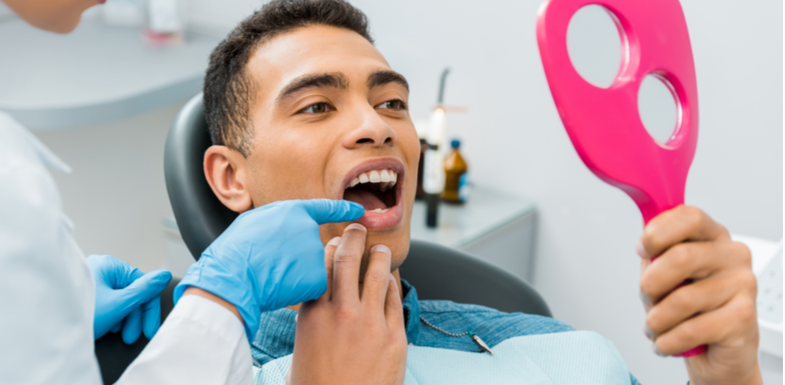Mandibular tori is a dental condition that affects an estimated 10% of the U.S., and most patients don’t even know it. If complications arise, though, you will definitely want to know more about mandibular tori removal. This is what to expect.
What are mandibular tori?
Mandibular tori are harmless, symmetrical growths of bone that occur under the tongue in your lower jaw (the mandible that lends them their name).
They are one of three types of torus. The other two are:
- Maxillary tori (also known as palatal tori or torus palatinus) that occur in the upper palate in the center of the upper arch of your teeth
- Buccal exostoses, the rarest of the three and seen on the upper molars on the outside of the upper arch (touching the cheek)
All of these grow very slowly. Development is influenced by four main risk factors.
- Gender: Tori show gender preference, with men more affected by mandibular tori, and palatal tori more common in women.
- Genetics: If your parents had tori of any kind, your risk increases. Approximately 40-60% of children whose parents have tori develop them also.
- Bruxism: In addition to creating a host of other dental issues, teeth grinding and jaw clenching stimulates bone growth, often in the form of tori.
- Injury: Injury seems to prompt bone growth as well, so any blow to the jaw or head can cause tori to develop.
A mandibular tori is slow growing, and this is the reason that many people never know they have one. Once you have it, though, you have it. A mandibular tori (or any other torus) does not go away on its own.
Types of mandibular tori removal
In most cases, mandibular tori are so mild that people don’t even know they are there. For an unfortunate few, the tori grow together, rubbing during the course of normal activities like talking and eating. Some people find that food gets stuck under them, causing a host of other dental issues. In older people, prominent tori may make it challenging to fit dentures comfortably. If any of these situations occur, you may need mandibular tori removal.
Mandibular tori removal can be done with traditional surgical techniques or with a laser.
Traditional surgical mandibular tori removal requires general anesthesia, with traditional surgical techniques to remove the growth.
Waterlase tori removal uses a laser and a stream of water to remove the bony growths without drilling. This is a less invasive procedure that cuts post-operative pain dramatically, reduces swelling and bleeding, and minimizes the need for pain medications, both during and after the procedure.
What to expect with a mandibular tori removal
The procedure for traditional surgical tori removal is like any other surgery. The patient receives general anesthesia, and the dentist uses a scalpel to access the bone and a drill to remove it.
Although the surgery is not necessarily more uncomfortable than a wisdom tooth extraction, the oral surgeon may need to use chisels and mallets to loosen the bone to remove it. Most patients are understandably uncomfortable with the image and feelings of this and prefer sedation.
For laser tori removal using Waterlase, patients receive a local anesthetic before the procedure. Because there is no heat or vibration, and very little sound, even patients who are anxious about dental work are comfortable with just local numbing. If you are still concerned, talk to your dentist about other options. Your overall comfort is important.
The dentist then uses the laser to access the mandibular tori, adjusting the laser to remove the bone. When the procedure is done, they will use the laser to “bandage” the area to promote fast healing. In rare cases, sutures are not necessary, but most patients do require a few stitches.
Of the two types or mandibular tori removal, laser tori removal is the less invasive and offers the fastest healing times with fewer complications. If you have complicating factors, though, your dentist may opt for surgical removal.
Mandibular tori removal recovery
After your tori removal, it’s important to follow all recovery procedures given by your dentist. In general, though, follow these guidelines for a quick and comfortable recovery.
- Take prescription medications only as prescribed: In the case of laser tori removal, over-the-counter non-steroidal anti-inflammatory drugs (NSAIDs, like ibuprofen) may be the only pain medication you need
- Finish your antibiotics: Not everyone will receive a prescription for antibiotics, but if you do, finish the entire course
- Practice good oral hygiene: Rinse your mouth gently with saltwater and brush carefully twice a day
- Watch your diet: Eat soft, bland foods like yogurt, soups, and scrambled eggs in the days following surgery
- Avoid certain foods: Spicy, crunchy, or very hot foods may irritate the surgical site
Laser tori removal sees an average full recovery time of about two weeks. Traditional surgical removal recovery may take a month or more.
Mandibular tori removal complications
Laser tori removal comes with few complications, but, as with all surgical procedures, any time you open up the skin there is the possibility of complications. Common side effects may include bleeding, swelling, and some pain. Generally, you can control these with the guidelines above.
If you experience excessive pain, additional bleeding, and swelling that won’t go down, this could indicate a possible infection. If you experience a fever and a general feeling of being unwell, call your dentist.
Mandibular tori can (and do) grow back. If there are underlying causes that can be treated (e.g., bruxism), addressing those may help prevent them from re-occurring.
Do I need mandibular tori removal?
As noted above, most people with mandibular tori go their whole lives without even knowing they have them. When tori begin to interfere with talking, eating, or speaking, or if you need dentures but they cannot be fitted properly, it’s time to talk about removal.
AZ Dentist specializes in gentle mandibular tori removal. Schedule a consultation today to learn more.
